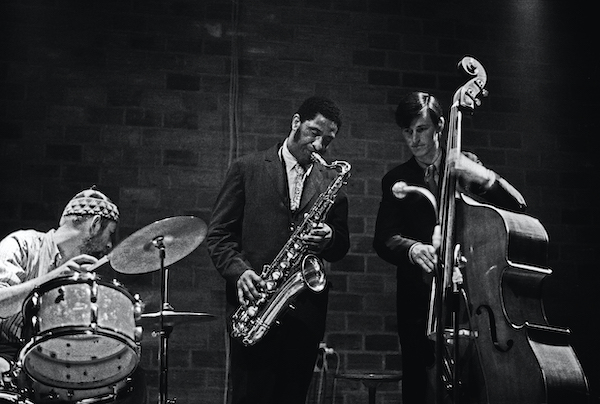Oct 28, 2025 10:47 AM
In Memoriam: Jack DeJohnette, 1942–2025
Jack DeJohnette, a bold and resourceful drummer and NEA Jazz Master who forged a unique vocabulary on the kit over his…

Han Bennink (left), Sonny Rollins and Ruud Jacobs in concert at the Academie voor Beeldende Kunst in Arnhem, The Netherlands, the evening of May 3, 1967
(Photo: Toon Fey)Sonny Rollins lives firmly in the present. The esteemed tenor saxophonist—whose voice as a cutting-edge jazz artist came into full bloom during the 1950s and ’60s—retired from playing concerts in 2012 and put down his horn for good two years later.
Now, instead of practicing and preparing for gigs and tours, he spends his days at his home in upstate New York reading up on Eastern religions and immersing himself in the mental and spiritual aspects of yoga, a discipline Rollins has practiced continuously since the mid-’50s. During a phone interview in October, the 90-year-old NEA Jazz Master and DownBeat Hall of Famer came across as an enlightened guru of good vibes who’s perfectly at peace with his circumstances—and with the world at large.
Lately, though, he has been revisiting the past, giving his blessing to the release of Rollins In Holland, a collection of live and studio recordings documenting a 1967 Netherlands tour. Rollins is pleased by what he hears: a powerhouse jazz trio consisting of himself and the Dutch rhythm tandem of bassist Ruud Jacobs (1938–2019) and drummer Han Bennink, playing with attitude, energy and deftness over the course of two club performances and one studio session.
When Rollins arrived in Holland in May of that year, he was no stranger to the jazz trio format. Some of his strongest work already was documented on the 1957 Contemporary album Way Out West (with bassist Ray Brown and drummer Shelly Manne), the 1958 Riverside LP Freedom Suite (with bassist Oscar Pettiford and drummer Max Roach) and the 1958 Blue Note release A Night At The Village Vanguard (from sets with bassist Wilbur Ware and drummer Elvin Jones and with another tandem, bassist Donald Bailey and drummer Pete LaRoca).
Prior to the Netherlands tour, Rollins, then 36, had never before performed with Jacobs or Bennink, two local players in their 20s who represented vastly different styles on the jazz spectrum. Previously, the pair had backed up Johnny Griffin, Ben Webster, Wes Montgomery and other American jazz stars. But Rollins was their hero, and they were extremely well versed in the saxophonist’s substantial oeuvre.
“Ruud Jacobs was the bass player of choice for anybody that came through Holland,” Rollins recalled. “I found out later that Ruud played with Louis Armstrong. He had one of these great contrabasses made in Europe. The sound was so rich and full. I loved Ruud’s playing, and I loved his sound.
“Han Bennink was known as the more avant-garde guy,” Rollins continued. “I was told they had distinct styles, but I didn’t think about that at all, because I could play with both of them. And they both knew something about me. So, it was wonderful to have them play together. I was very happy to have them there as my backup trio.”
It was a big job—heavy lifting, to say the least—to back up Rollins in that context.
“If I would go on stage with just a drummer and a bass player, those guys have to be very proficient,” the saxophonist said. “The drummer has to be excellent, and the bass player has to be excellent, because they’re playing everybody else’s part that’s not there. That’s what I need to play with a trio. I need to have a bass player that really is a bass player—somebody like Oscar Pettiford or Ray Brown, or Niels-Henning [Ørsted Pedersen] in Europe.

Jack DeJohnette boasted a musical resume that was as long as it was fearsome.
Oct 28, 2025 10:47 AM
Jack DeJohnette, a bold and resourceful drummer and NEA Jazz Master who forged a unique vocabulary on the kit over his…

D’Angelo achieved commercial and critical success experimenting with a fusion of jazz, funk, soul, R&B and hip-hop.
Oct 14, 2025 1:47 PM
D’Angelo, a Grammy-winning R&B and neo-soul singer, guitarist and pianist who exerted a profound influence on 21st…

Kandace Springs channeled Shirley Horn’s deliberate phrasing and sublime self-accompaniment during her set at this year’s Pittsburgh International Jazz Festival.
Sep 30, 2025 12:28 PM
Janis Burley, the Pittsburgh International Jazz Festival’s founder and artistic director, did not, as might be…

Jim McNeely’s singular body of work had a profound and lasting influence on many of today’s top jazz composers in the U.S. and in Europe.
Oct 7, 2025 3:40 PM
Pianist Jim McNeely, one of the most distinguished large ensemble jazz composers of his generation, died Sept. 26 at…

Drummond was cherished by generations of mainstream jazz listeners and bandleaders for his authoritative tonal presence, a defining quality of his style most apparent when he played his instrument unamplified.
Nov 4, 2025 11:39 AM
Ray Drummond, a first-call bassist who appeared on hundreds of albums as a sideman for some of the top names in jazz…